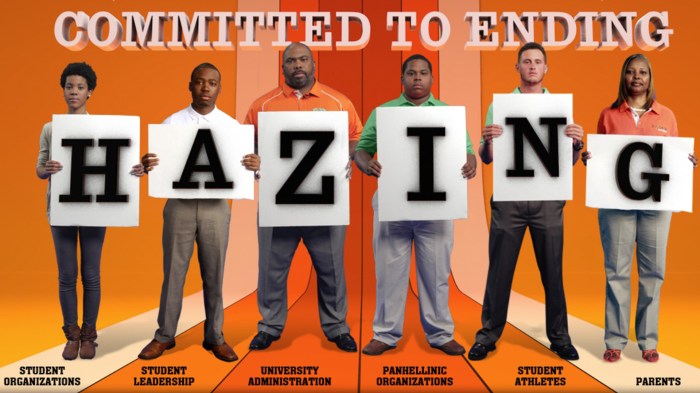When can hazing prevention happen? Hazing prevention can occur at various stages, including before, during, and after hazing incidents. Understanding the optimal timing for intervention is crucial to effectively address and prevent this harmful practice.
This article explores the different opportunities for hazing prevention, emphasizing the importance of proactive measures and continuous efforts to create a culture of respect and inclusivity.
Understanding Hazing Prevention: When Can Hazing Prevention Happen

Hazing refers to any action or behavior that intentionally or unintentionally harms, degrades, or endangers individuals within a group or organization. These actions often involve humiliation, physical abuse, or psychological torment and are used as a means of initiation or maintaining membership within the group.
Hazing is a serious problem with negative consequences for both individuals and the groups involved. It can lead to physical injuries, emotional trauma, mental health issues, and even death. Hazing also creates a hostile and intimidating environment that undermines the values of respect, inclusivity, and dignity.
Statistics show that hazing is a prevalent issue in various settings, including schools, universities, sports teams, and fraternities. Studies have found that a significant percentage of students and athletes have experienced some form of hazing during their time in these organizations.
Identifying Opportunities for Prevention
To effectively prevent hazing, it is crucial to identify potential opportunities for intervention. This involves creating a culture that values respect, inclusivity, and open communication. Institutions and organizations should establish clear policies and procedures that prohibit hazing and provide support for individuals who report or witness hazing incidents.
Another important aspect of prevention is identifying high-risk situations or groups where hazing is more likely to occur. This may include groups with a strong emphasis on hierarchy, competition, or exclusivity. By recognizing these risk factors, institutions can implement targeted prevention strategies to address them.
Empowering bystanders to play a role in preventing and reporting hazing is also essential. Bystanders can be educated on the signs of hazing and encouraged to speak up if they witness or suspect any inappropriate behavior.
Implementing Prevention Programs
Implementing effective hazing prevention programs is crucial for creating a safe and respectful environment. These programs should be comprehensive and include a variety of components, such as:
| Program Type | Description |
|---|---|
| Education and Awareness | Providing information about hazing, its consequences, and resources for reporting and support. |
| Policy Development | Establishing clear policies and procedures that prohibit hazing and Artikel consequences for violations. |
| Training and Training | Training for staff, students, and athletes on hazing prevention, including how to recognize, report, and respond to incidents. |
| Monitoring and Evaluation | Regularly monitoring and evaluating prevention efforts to ensure effectiveness and make necessary adjustments. |
Successful hazing prevention programs often involve collaboration between multiple stakeholders, including administrators, faculty, students, and parents. By working together, these groups can create a comprehensive approach to prevention that addresses the issue from multiple perspectives.
Engaging Stakeholders
Engaging stakeholders is essential for the success of hazing prevention efforts. This includes:
- Administrators and policymakers: Setting policies and procedures, providing resources, and creating a supportive environment.
- Faculty and staff: Educating students, monitoring behavior, and reporting suspected hazing incidents.
- Students: Participating in prevention programs, reporting hazing incidents, and creating a culture of respect and inclusivity.
- Parents and community members: Supporting prevention efforts, providing resources, and holding institutions accountable.
Collaboration and communication among these stakeholders are crucial for effective prevention. This can be achieved through regular meetings, task forces, and communication channels dedicated to hazing prevention.
Evaluating Prevention Efforts, When can hazing prevention happen
Evaluating hazing prevention programs is essential to ensure their effectiveness and identify areas for improvement. This involves:
- Setting clear goals and objectives for prevention efforts.
- Collecting data on the prevalence of hazing, reporting rates, and other relevant indicators.
- Analyzing data to identify trends, patterns, and areas where prevention efforts are succeeding or falling short.
- Using evaluation data to make informed decisions about program adjustments and improvements.
Regular evaluation allows institutions to refine their prevention strategies and ensure that they are meeting the needs of their communities.
Clarifying Questions
What are the signs of hazing?
Hazing can manifest in various forms, including physical abuse, humiliation, sleep deprivation, forced consumption of substances, and isolation from peers.
What should I do if I witness or experience hazing?
Report it immediately to a trusted adult, such as a teacher, counselor, or law enforcement officer. Do not engage in or tolerate hazing behavior.
How can I help prevent hazing?
Promote a culture of respect and inclusivity, challenge harmful traditions, and support anti-hazing initiatives in your community.
